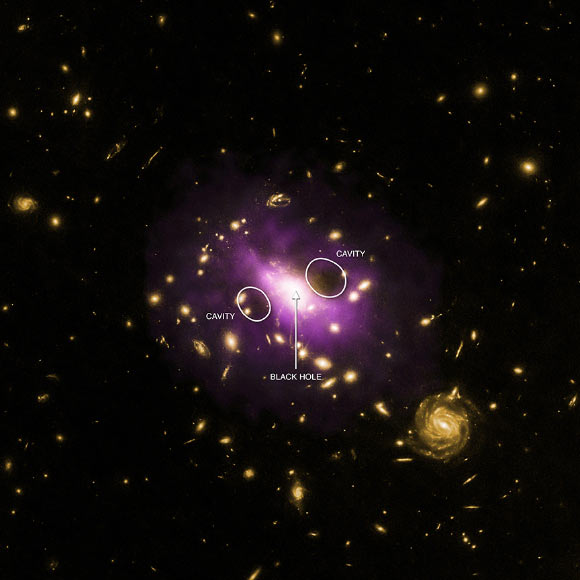An enormous black hole located in the center of the galaxy cluster RX J1532.9+3021 (RX J1532 for short) is one of the most powerful black holes in the known Universe, according to a team of astronomers from Europe and the United States.

This is a composite image of the galaxy cluster RX J1532.9+3021, located about 3.9 billion light-years from Earth. The labels show the location of two enormous X-ray cavities, created by jets from a central black hole that have pushed aside hot gas. Image credit: X-ray – NASA / CXC / Stanford / J. Hlavacek-Larrondo et al.; optical – NASA / ESA / STScI / M. Postman & CLASH team.
RX J1532 lies in the constellation Corona Borealis, about 3.9 billion light-years from Earth.
It is a highly X-ray luminous, and therefore massive cluster of galaxies, with a mass about 950 trillion times that of the Sun.
The large amount of hot gas near the RX J1532’s center presents a puzzle. Hot gas glowing with X-rays should cool, and the dense gas in the center of the cluster should cool the fastest. The pressure in this cool central gas is then expected to drop, causing gas further out to sink in towards the galaxy, forming trillions of stars along the way.
However, astronomers have found no such evidence for this burst of stars forming at the center of this cluster.
This problem has been noted in many galaxy clusters but RX J1532 is an extreme case, where the cooling of gas should be especially dramatic because of the high density of gas near the center.
What is stopping large numbers of stars from forming in RX J1532?
The astronomers have used power of NASA’s Chandra X-ray Observatory and a suite of other telescopes to answer this question.
The X-ray image shows two large cavities in the hot gas on either side of a large elliptical galaxy at the cluster’s center. Both cavities are aligned with jets seen in radio images.
The location of the supermassive black hole between the cavities is strong evidence that the supersonic jets generated by the black hole have drilled into the hot gas and pushed it aside, forming the cavities.
Shock fronts – akin to sonic booms – caused by the expanding cavities and the release of energy by sound waves reverberating through the hot gas provide a source of heat that prevents most of the gas from cooling and forming new stars.
The cavities are each about 100,000 light years across, roughly equal to the width of the Milky Way galaxy. The power needed to generate them is among the largest known in galaxy clusters.
Although the energy to power the jets must have been generated by matter falling toward the black hole, no X-ray emission has been detected from infalling material.
This result can be explained if the black hole is ultramassive rather than supermassive. Such a black hole should be able to produce powerful jets without consuming large amounts of mass, resulting in very little radiation from material falling inwards.
Another explanation is that the black hole is spinning extremely rapidly. Such a black hole can produce more powerful jets than a slowly spinning black hole when consuming the same amount of matter.
In both explanations the black hole is extremely massive.
The findings have been published in a paper in the Astrophysical Journal (arXiv.org).
______
Hlavacek-Larrondo J et al. 2013. Probing the Extreme Realm of Active Galactic Nucleus Feedback in the Massive Galaxy Cluster, RX J1532.9+3021. ApJ 777, 163; doi: 10.1088/0004-637X/777/2/163







